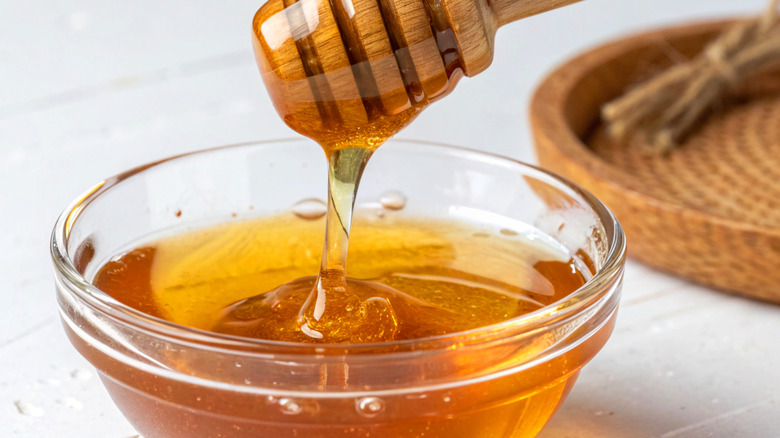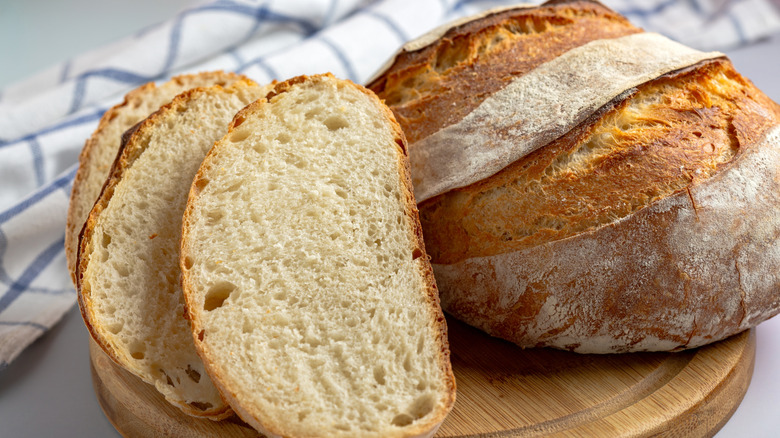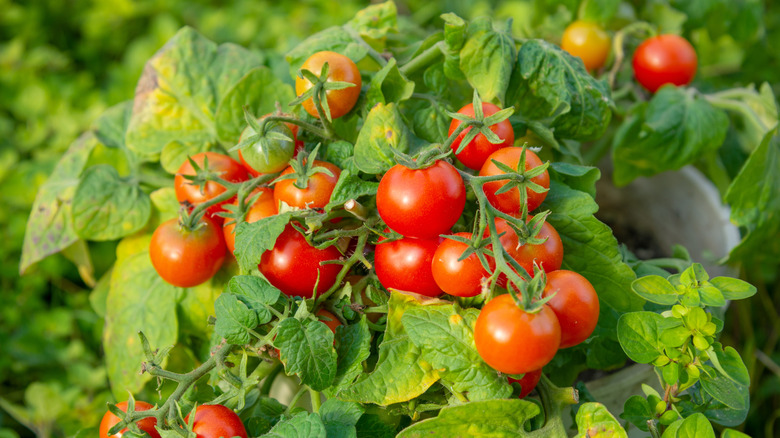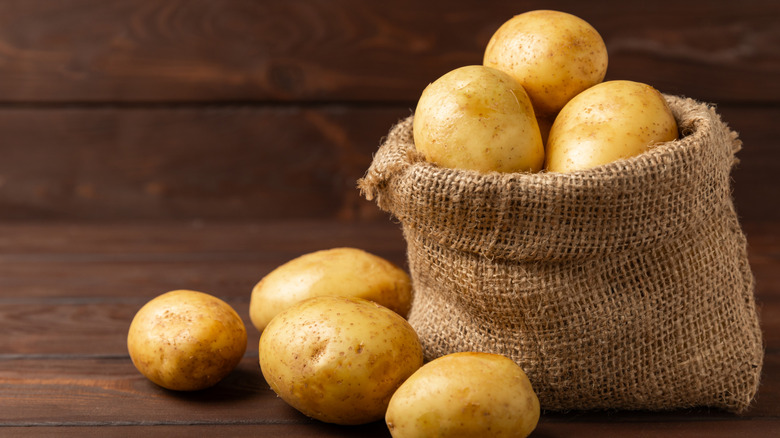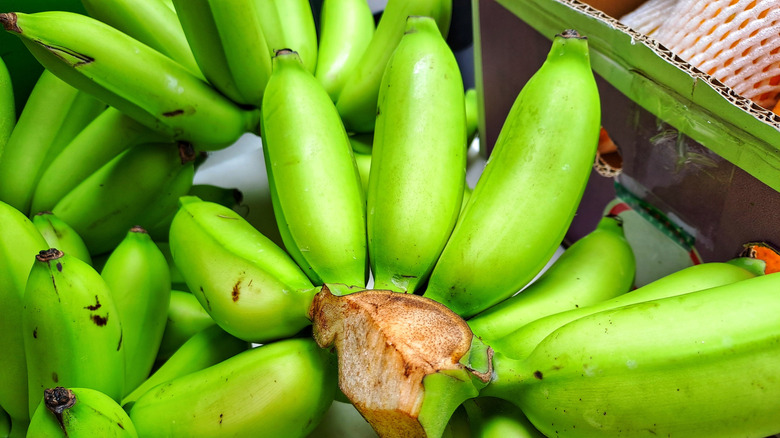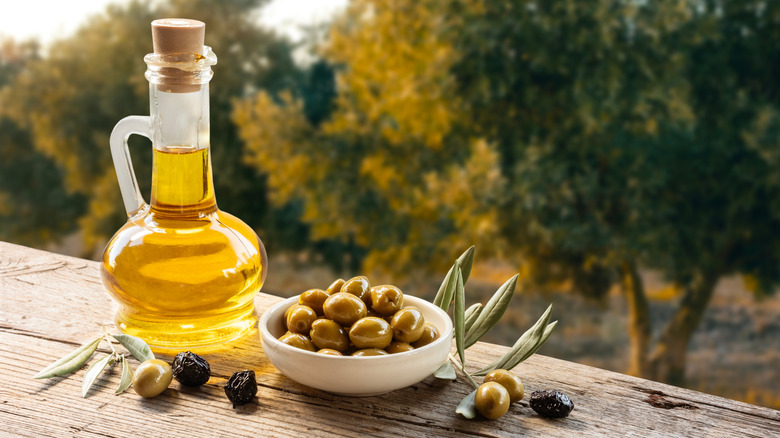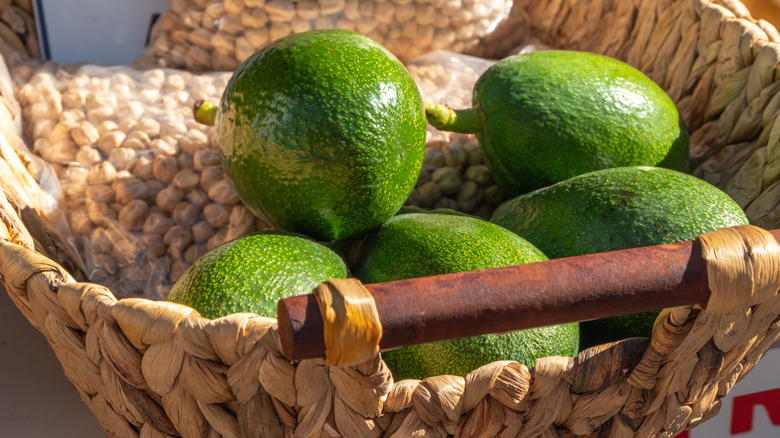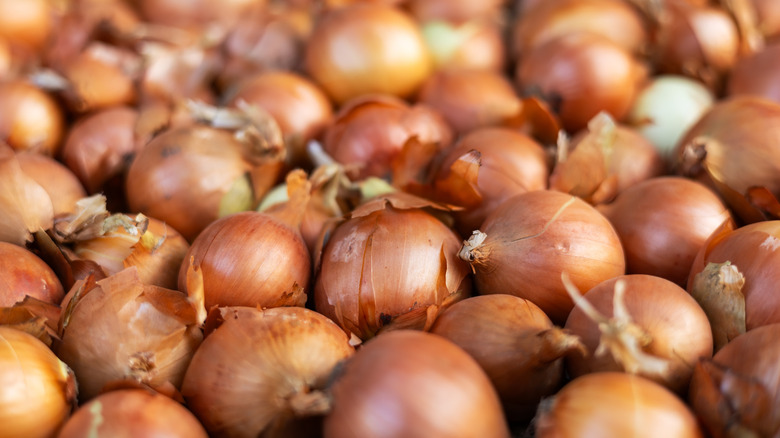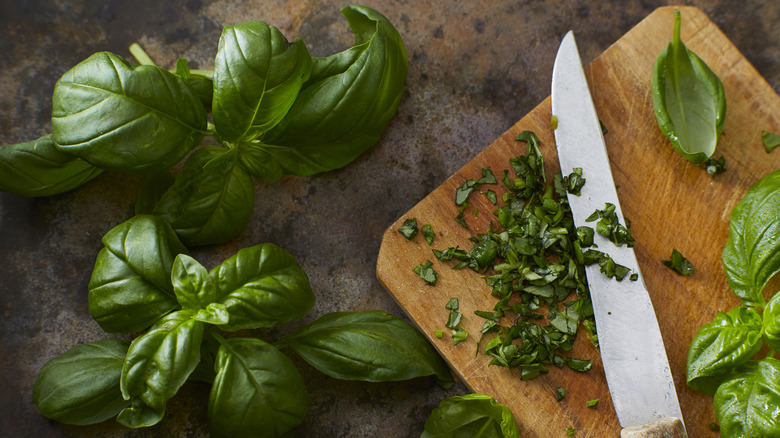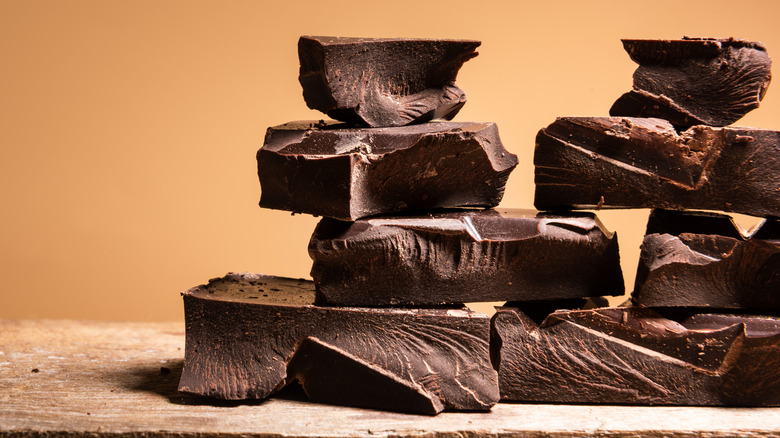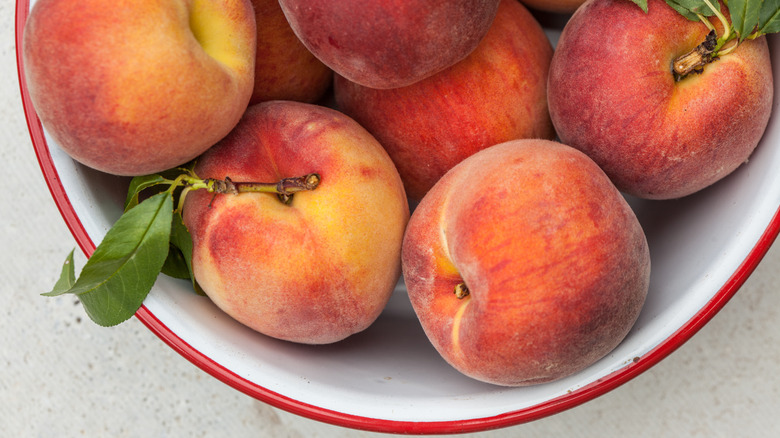12 Foods You Should Never Store In A Fridge
The first electric refrigerator for the home was patented in 1913, forever changing how we store and preserve food. Before that, perishables had to be consumed quickly, salted, or pickled. Suddenly, this new technology allowed them to stay fresh for days or even weeks. While we still use refrigeration to keep food fresh, for some kitchen staples, storage in cold temperatures may be counterproductive.
Many people mistakenly believe that storing all food groups in the fridge is a good idea because we have learned to associate cool environments with preserving freshness. When stocking up on groceries — and even buying products in bulk — we often automatically default to refrigeration, without taking into account whether a particular item will actually benefit from cold temperatures. As it turns out, some foods fare much better at room temperature than in the cold and can even spoil faster when refrigerated.
Ready to find out which common food items deteriorate in cold temperatures? Take a look at our list of some of the worst refrigeration mistakes you might be making!
1. Honey
A healthy alternative to sugar, honey can be drizzled over toast, used to sweeten tea and smoothies, or mixed into baked desserts for an added flavor kick. Honey is also shelf stable, meaning that you can store it in the kitchen pantry without the risk of it spoiling. Believe it or not, honey is one of the few foods that can last indefinitely without going off thanks to its low water content and high acidity.
Honey doesn't fare well in the refrigerator, since low temperatures can cause the glucose in the honey to crystallize. This, in turn, results in an unappealing opaque appearance and a thick, grainy texture. The good news is that crystallized honey remains safe to eat. In addition, you can easily bring honey back to its original liquid state by placing it in warm water. Alternatively, you can also microwave it, although this should be done in short intervals.
To keep honey in optimal condition, store it in a cool, dry place, away from direct sunlight — your kitchen pantry should do the trick. Furthermore, keep this natural sweetener fresh by storing it in an airtight glass or plastic container. Leaving the honey exposed to air runs the risk that its sugars will absorb moisture, leading to the formation of yeast.
2. Bread
Few culinary pleasures rival the satisfying crunch and tempting aroma of freshly baked bread. Regrettably, bread doesn't stay this way for long, as exposure to air makes it go stale in just a day or two. While keeping bread in the refrigerator may seem like a good idea, it can actually make bread go stale faster. This is because storing bread in the fridge leads to a process called starch retrogradation, where the starch molecules in the loaf recrystallize, leading to harder and drier product. As long as the refrigerated bread isn't too stale, reheating it in the oven or toaster can temporarily soften it, making it more palatable.
To ensure that your bread stays fresh as long as possible, place it in a paper bag or a bread box and store it in a cool and dry place. Bread should never be stored in plastic bags, as they can create a humid environment conducive to the growth of mold. If you know that you won't finish a loaf of bread within a few days, it's best to freeze it. Simply slice the bread, so it's easy to defrost and toast later and place it in a freezer-safe plastic bag, squeezing out as much air as possible before sealing the packaging.
3. Unripe tomatoes
Fresh tomatoes are a staple in many kitchens. Ultra versatile, the fruit (yes, tomatoes are a fruit!) can be tossed into salads, sliced into sandwiches, or incorporated in delicious pasta sauces. Given their wide range of uses, preserving the freshness and quality of tomatoes can save you time, effort, and money.
As a general rule, keep fresh tomatoes out of the refrigerator, as cold temperatures can affect both their flavor and texture. To cut a long story short, refrigeration leads to the expansion of the water inside the tomatoes, which, in turn, ruptures their cell walls and makes them mealy and mushy. It also dulls the fruit's flavor by slowing down the production of the compounds responsible for making tomatoes so sweet and delicious. Lastly, refrigeration stops unripe tomatoes from ripening, leaving them lacking in sweetness and flavor complexity.
To maximize their flavor and texture, tomatoes should be stored in a single layer at room temperature, away from direct sunlight. Be sure to store the tomatoes stem side down to minimize moisture loss. If you must refrigerate tomatoes, it's best to do so only after they have fully ripened. Once removed from the fridge, let the tomatoes come to room temperature before eating them.
4. Raw potatoes
The humble spud is the shining star of countless dishes, including French fries, potato gratin, and crispy hash browns. However, while it may seem convenient, refrigerating potatoes until you are ready to turn them into a culinary masterpiece can backfire. This is because refrigeration changes the sugar content of potatoes from sucrose into glucose and fructose, turning them sweet and gritty in texture.
Aside from altering their flavor and texture, refrigerating potatoes can pose an even bigger concern. When potatoes that have been kept in the fridge are cooked at high temperatures, their glucose and fructose react with asparagine — a natural amino acid in raw potatoes. This, in turn, can produce a potentially harmful chemical called acrylamide. If you do store raw potatoes in the fridge, it's best to soak them in water for around 30 minutes before cooking to release some of the sugars. In addition, avoid cooking refrigerated potatoes at temperatures above 338 degrees Fahrenheit to minimize the chances of acrylamide formation.
Luckily, if stored correctly, potatoes can remain fresh without refrigeration for relatively long periods of time. Start by checking your spuds for damage, as any cuts or bruises can accelerate spoilage. Never store potatoes in a plastic bag. Instead, opt for a breathable container like a cardboard box, paper bag, or mesh bag. Once packaged, it's best to store the spuds between 45 and 50 degrees Fahrenheit. Also, it's important to store them in a dark place, as exposure to light can turn them green.
5. Unripe bananas
Packed with nutrients, bananas make a healthy on-the-go snack. They are also a key ingredient in delicious treats like smoothies and banana bread. Of course, all of these possibilities go out the window if your bananas go rancid due to inappropriate storage.
Placing unripe bananas in the fridge stops them from ripening. As such, if you buy bananas while they are still green, it's best to keep them on the countertop until they are yellow and ready to enjoy. To extend their freshness, cover the banana stems with plastic or foil to slow down the release of ethylene gas, a natural compound that speeds up the ripening process. In addition, it's best to keep bananas away from other fruit that emit ethylene, such as apples, peaches, and tomatoes.
Bananas left at room temperature won't stay perfectly yellow for long, inevitably turning brown and mushy. This is why bananas that have reached their sweet spot of ripeness are actually best stored in the fridge. Even then, refrigeration will only preserve them for another day or two, with the cold temperature eventually darkening the fruit's skin.
6. Olive oil
Olive oil is a staple of the Mediterranean diet, and for good reason. Not only does it add depth to dishes, but it is also rich in antioxidants and healthy fats. It also features anti-inflammatory properties, which have been linked to reduced risks of heart disease, arthritis, and type 2 diabetes. That said, to ensure that olive oil maintains its quality, it's important to store it correctly.
Storing olive oil in the refrigerator isn't recommended, as cold temperatures alter its flavor and texture. Olive oil is a fat that retains its liquid consistency at room temperature. However, it begins to solidify at around 54 degrees Fahrenheit. This is why olive oil stored in the fridge becomes chunky and cloudy. If the temperature drops low enough, olive oil crystallizes and eventually solidifies, making it impossible to pour. Additionally, repeated refrigeration and thawing can lead to condensation inside the bottle, gradually degrading the oil's quality.
To ensure that olive oil stays at its best, store it in a cool, dark place like a pantry or kitchen cabinet. Be sure to keep the bottle tightly sealed, as air exposure can lead to oxidation and make the oil rancid over time. Once opened, olive oil has a shelf life of around a year, but ideally should be consumed within a couple of months.
7. Unripe avocados
Whether in salads, tacos, or sushi, the rich and creamy texture of avocados can elevate countless culinary creations — that is, if the avocados are perfectly ripe. Unripe avocados are usually overly hard and bland in flavor, while overripe ones can be mushy and unappetizing.
How you should store an avocado depends on its stage of ripeness. Unripe avocados, which are light green in color and hard to the touch, should be kept on the kitchen counter — never in the refrigerator. This lets the fruit ripen naturally over several days. To speed up the ripening process, place the avocado in a tightly closed paper bag and store it in a warm area of the kitchen. To accelerate the ripening process even more, store the avocado with ethylene-producing fruit and vegetables like apples or bananas.
Once the avocado turns a deeper shade of green and becomes soft to the touch, it's ready to enjoy. However, if you aren't in the mood to eat it just yet, you can extend the shelf life of a ripened avocado by transferring it to the fridge. If you have already cut the avocado in half, brush it with lemon or lime juice to stop it from browning before covering it in cling wrap and placing it in the fridge.
8. Uncut onions
If you have been storing onions in the crisp drawer of your refrigerator, you are in for a surprise. The versatile vegetable fares much better at room temperature than in the cool confines of the fridge. In fact, placing onions in cold temperatures makes them soft and soggy. Whether red, yellow, or white, onions are best stored in cool, dry, well-ventilated places like your kitchen pantry or even your home garage. That said, never store onions in a plastic bag, as this can make them overly moist, leading to spoilage. Instead, put them in breathable packaging like mesh bags or netting.
Once cut in half or chopped up, onions should be placed in an airtight container or a plastic bag and stored in the refrigerator. For optimal quality, aim to eat them within five to seven days. Onions that are kept in the fridge for too long will start to stink, potentially infusing all your other food with a strong oniony odor. Alternatively, freeze cut or chopped onions for up to six months.
9. Coffee beans
Many people store coffee beans — and coffee grounds — in the fridge, thinking that it preserves freshness. However, this is a misconception that couldn't be further from the truth. Placing coffee beans in the refrigerator can actually degrade their quality faster than storing them in a cool, dry cupboard. This is because coffee absorbs moisture, and storing coffee in the fridge exposes it to condensation, which can dull its flavor. Coffee is also naturally porous and can easily take on the odors of any other food items you may be storing in the refrigerator.
To preserve the quality of coffee beans as long as possible, store your Arabica and Robusta in a cool, dry place — after all, moisture is the enemy here. Whether whole or ground, it's best to store coffee in an airtight container. For the best cup of Joe possible, grind your beans right before use — coffee beans start to deteriorate right after they are ground, so brewing them immediately ensures the most flavor. If stored correctly, coffee beans will maintain their quality for up to a month, while ground coffee tends to stay fresh for one to two weeks.
10. Fresh basil
Whether sprinkled over a pizza or blended into a pasta sauce, fresh basil can impart dishes with a distinctive aroma and a burst of aromatic flavor. The challenge, however, lies in preserving this versatile herb's freshness. After all, unless you grow your own basil, you may need to rely on storage tricks to extend the shelf life of your store-bought supply.
Unlike most herbs, which should be stored in the refrigerator with their stems submerged in water, the best way to store basil is keeping it at room temperature. There is a very simple reason for this — unlike cool weather crops like parsley, cilantro, and chives, basil thrives in warm climates. As such, storing basil in the refrigerator is likely to damage its leaves, even turning them completely black.
To keep basil fresh, trim its stems and place the herb in a glass of water — just imagine how beautiful this green bouquet is going to look on your kitchen countertop. If you have purchased fresh basil without stems, place the loose leaves in an open plastic bag and keep it on your countertop.
11. Chocolate
Chocolate forms the basis of countless recipes, from no-bake brownies to matcha chocolate chunk cookies. As such, it's not surprising that chocolate is a staple in many kitchens. It's also frequently stored in the refrigerator — a practice that may seem logical but can actually do more harm than good.
Placing chocolate in the refrigerator can alter both its texture and flavor. First, chilling chocolate can result in a "sugar bloom," which happens when chocolate is transferred from cold storage to room temperature. While this doesn't make the chocolate unsafe to eat, it's likely to make it whitish and gritty — a result of moisture dissolving the sugar and then recrystallizing. Chocolate is also one of those products that readily absorbs odors, which means that it can easily take on the smells of nearby items like leftovers from last night's dinner.
Just like many other kitchen staples, it's best to keep chocolate in a cool, dry, and dark place. If stored properly, milk chocolate should retain its quality for around a year, while dark chocolate can last up to two years. That said, if the temperature in your home reaches 82 degrees Fahrenheit, it may be time to rethink your strategy to prevent the chocolate from melting. If you absolutely must refrigerate chocolate, store it in an airtight container and remove it from the fridge 30 minutes before consumption to restore its texture and flavor.
12. Some unripe stone fruits
Just as their name suggests, stone fruits contain a large, hard pit or seed. Some of the more popular stone fruits include peaches, plums, nectarines, and apricots — all of which are ideal for baking, turning into jams, and enjoying fresh. While they all have slightly different shelf lives, stone fruits don't last very long once harvested. Nevertheless, you won't be doing yourself any favors if you toss these fruits in the fridge before they are ready to eat — the cold is likely to slow down or even stop their ripening.
Not only do refrigerated stone fruits fail to ripen, they may also develop an unpleasant texture. Stone fruits are prone to "chilling injury" if they are stored at temperatures below 50 degrees Fahrenheit, which can result in brown spots and mealy texture. For best results, allow stone fruits to ripen at room temperature, and only store them in the fridge once fully ripe to extend their life for a day or two. Notably, the no-fridge rule doesn't apply to one type of stone fruit — cherries. These can be stored in the refrigerator, provided that they are dry and placed in a breathable bag.

